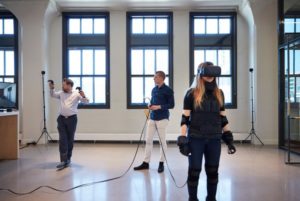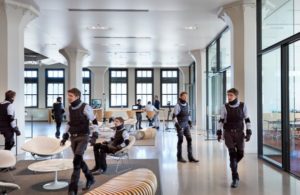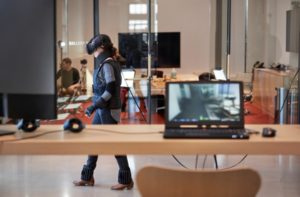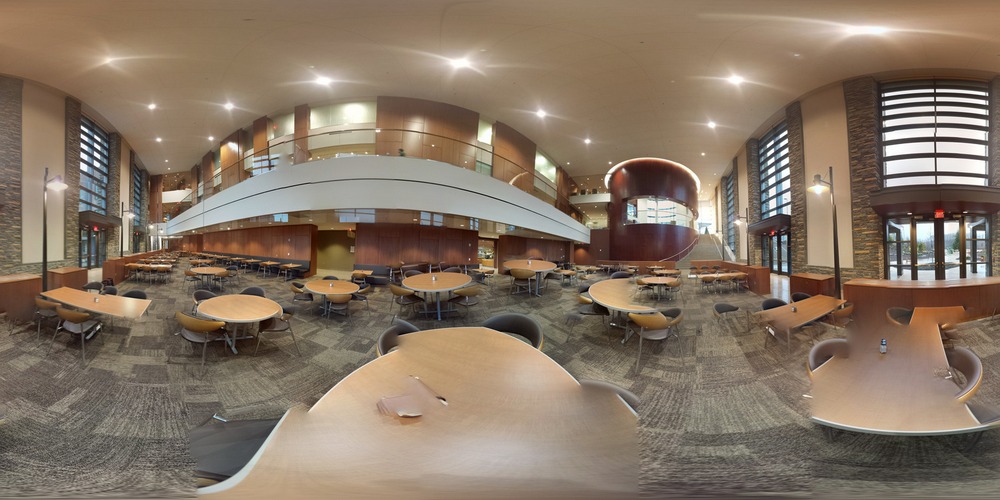Healthcare facility planning is changing as virtual reality enables clients, users and owners to step into the planning process as never before. High-tech buzzwords – Revit, cloud, mobile apps, augmented reality and virtual reality – are becoming the transformative tools of the trade. Over the past few years, virtual mock-ups viewed through headsets and glasses have enhanced the architectural planning and design process, leading to better collaboration with user teams and improving project delivery.

Realigning Planning
Planning traditionally follows a linear process, from concept phase to schematic design to design development to construction. Multiple in-person meetings between planning and design teams, clients and user groups help to identify goals and challenges, which the team then develops into concept options using sketches, diagrams and eventually Revit.
The challenge for clients and user groups, who may be unfamiliar with the planning and design process, is that diagrams, drawings and other 2-D media can be difficult to understand. This can lead to misunderstandings, resulting in costly changes and scheduling delays.
Yet by taking advantage of evolving high-tech tools, virtual reality can teleport clients and users into concepts early on in the process and allow them to walk through virtual spaces to better understand department layouts, adjacencies, workflows and room finishes. New concepts and trends can be introduced and tested in real time through the comprehensive Revit family library, allowing planners and designers to share numerous clinical experiences with clients as they determine the best solutions. Revisions can then easily sync back to the Revit model and be developed further in later phases.
The virtual reality experience can expedite the entire process, reducing schedules by achieving conclusions faster. Additionally, virtual reality presents opportunities to replace some in-person meetings with remote meetings or virtual walk-throughs via web portals, ultimately eliminating the challenges of assembling large client groups for review sessions and milestone decisions. This can be particularly helpful with international projects, saving overseas travel time and costs.
For instance, during recent presentations at the Healthcare Infrastructure Technology & Engineering Conference and the 4th Annual Healthcare Facilities Asia Conference, both held in Singapore this year, HGA Architects & Engineers talked with clients who confirmed the benefits of VR in the healthcare planning process.
Many view VR as a user-friendly interactive tool that enhances the planning/design process and understanding for project teams. They mentioned specific advantages, such as “interactive virtual user meetings,” where participants can meet in the concept model during planning/design phases via any device accessing a cloud or web portal. This could lead to reducing the number of “in-person user meetings,” they noted, which equates to substantial consultant travel cost savings for the owners.
Additionally, both international and domestic clients the firm met with see potential efficiencies in overall schedules due to a better understanding of their building, which can lead to early sign-off on plans and fewer changes later in the process. Some clients even noted physical mock-ups may not be necessary in the future based on the realistic detail in VR models.
Evolving Technology
Specific tools depend on the unique design challenge, and the technology is quickly evolving. Today’s technology includes:
- Motion controls – These controls allow the user to see his or her hands and interact with the virtual environment through Vive controllers, Oculus Touch controllers and Leap Motion hand-gesture recognition
- Large-scale positional tracking – The Vive 15X15 technology allows the user to fully explore and navigate spaces without causing motion sickness
- Multiplayer virtual reality experiences – Such experiences allow more than one person in a space and enable both clients and planners alike to collaborate remotely
- Software development applications – Customized apps and tools can be developed to meet specific design challenges or validate Evidence-Based Design concepts

The Empathy Effect
Beyond the time and cost benefits of utilizing virtual reality for medical planning, new digital technology is changing the ways designers approach their projects. Not only can virtual reality allow clients to visualize space, but it can also help designers understand how users will interact with it. Virtual reality allows designers to better comprehend the broad spectrum of experiences people may have in a space through augmented reality, from older individuals with physical and sensory limitations, to people with impaired vision or other disabilities, to children who will experience a space differently due to their height.
In one case study focusing on age, designers from various disciplines wore a body suit that hindered arm and leg movements, along with a virtual reality headset that immersed them in a healthcare environment. Digital filters were applied to the virtual reality experience that simulated vision impaired by cataracts, glaucoma or macular degeneration. Meanwhile, other team members observed and monitored their responses. A video of the experience, with participant comments, can be seen here.
The same team also developed a VR experience that replicated how a child would experience being in various spaces. In this study, the team adjusted the height of objects in the spaces in relationship to the headset wearer to mimic how a child experiences height.

The designers found that with both the virtual reality tools and simulation suit, they were able to garner insight into either the physical challenges affecting those with advanced age or disabilities or the height limitations of children. With that level of empathy, in both cases they could better imagine and plan environments to create a positive impact for the full scope of those who would experience them.
Takeaways
Virtual reality offers tangible benefits to the healthcare planning process. By working with a design team using VR, one can:
- Engage user groups and stakeholders earlier in the process
- Test concepts virtually to determine preferred options
- Expedite the planning and design processes
- Create better understanding of overall facility and spaces
- Minimize revisions and change orders
- Reduce schedules and costs
- Increase empathy among designers, clients and end users
Virtual reality technology is evolving at a rapid pace, and this will offer more opportunities for healthcare clients and users to immerse themselves in the planning process with their design team. With a greater understanding of the planning process, clients will be able to avoid costly rework and direct those savings toward better-planned spaces that improve workflow and, ultimately, enable caregivers to deliver better service to patients.




